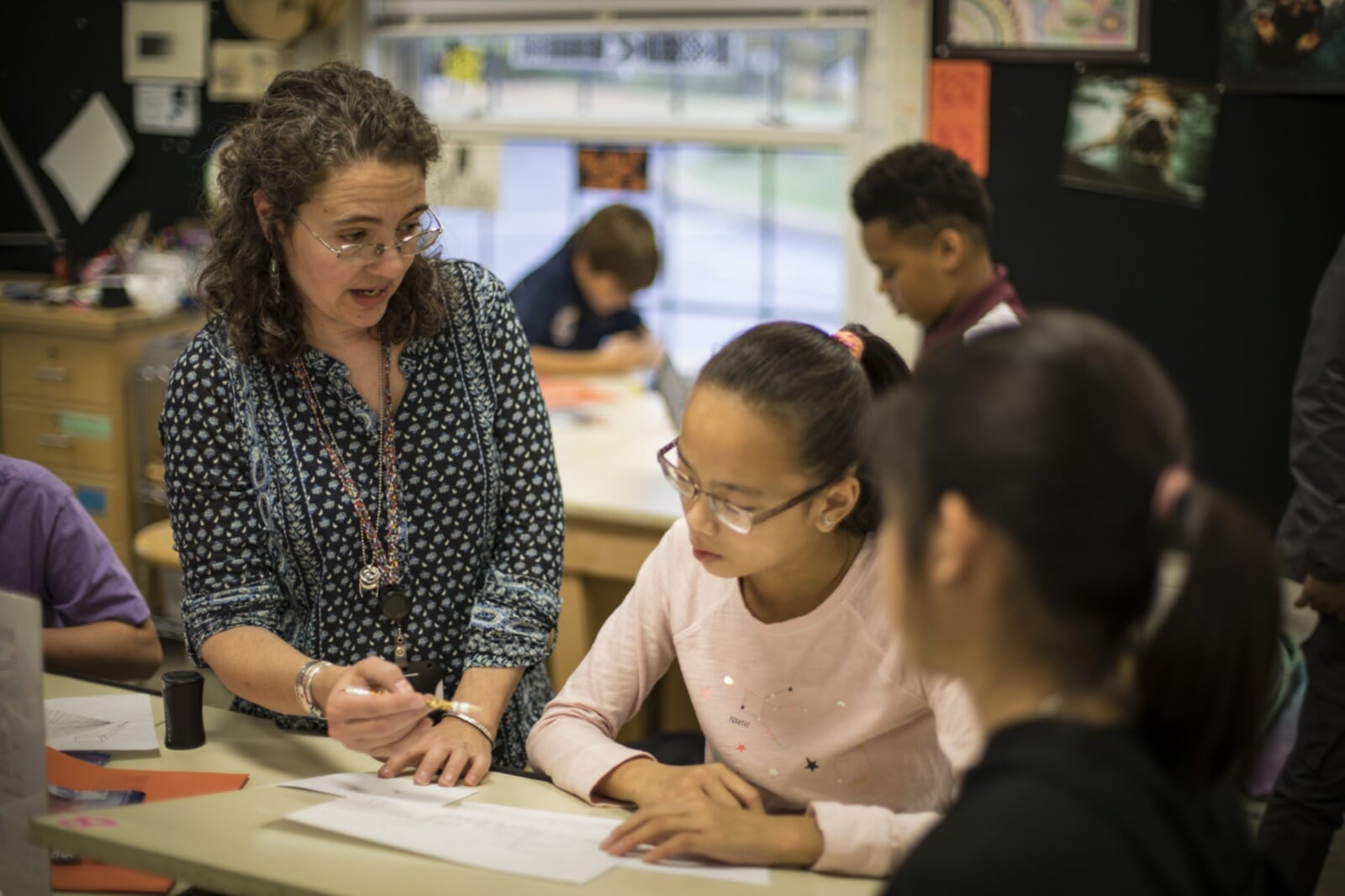Using Technology to Support Teaching
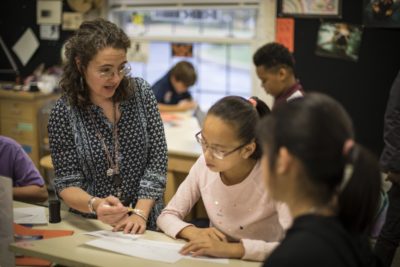 By JoAnne Vogel, Middle School Fine Arts Department Chair & Visual Art Teacher
By JoAnne Vogel, Middle School Fine Arts Department Chair & Visual Art Teacher
I’m walking down the hall and quickly glance at my cell phone to check the time. Relieved to see that the meeting has a few minutes before it begins, I enter the room. A scan helps identify the best seat: close to the front and removed from the social clusters that are forming. I take my seat and the meeting begins. I pay close attention as the person is presenting; it takes much effort to filter out ambient noise and distractions. At the table behind me, two colleagues lean in and begin a side conversation. For what seems like an eternity, the side conversation derails my brain and as they end their conversation, I find that I have completely missed what was being presented during that time. I flounder to rejoin the topic and in doing so, miss more. Back in focus, I try to make sense of the remaining presentation. In conclusion, the presenter announces, “ Any questions?” I have many.
This is my normal. Having an auditory processing deficit, I have, over the years, learned to navigate my surroundings in order to interpret the world around me. Choosing my seat at a meeting to facilitate my deficit comes at a social and emotional cost. I definitely have to choose—what do I want to be today—attentive or social? This raises the question—if this is my experience as an adult, what are my students experiencing in my classroom? How is that impacting their ability to learn, grow, and enjoy their experience in the studio?
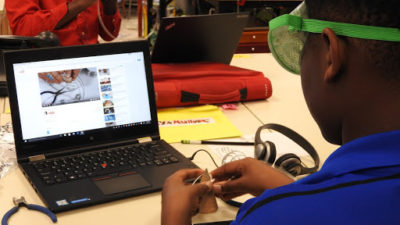
For years I used to do live demonstrations in my studio. When it was time for students to learn how to create a coil pot, I would have them gather around, and they would watch as I demonstrated how to work with the clay and teach them new tools and techniques. Afterward, students would go back to their seats and begin to work. The demonstration was just like my meeting—all it would take was one side conversation for a student to lose track and miss information. Where would that leave them when it was time to create? (Answer: Without all the resources and support to be successful in my class.) To regain those resources and information, they would need to ask me individually for extra help. The dynamic this created was that students who are able to absorb new information in a distracting setting would move forward, while those who struggle with that would be left behind. Naturally, behavior suffers when a student is unable to move forward and engage in the exercise. The result is their creative outcome had nothing to do with their ability and all to do with their access to the information. Students might find themselves in the position to make similar choices like I do for my meetings—do I socially disengage so that I can keep up with the demands of the class? Think about the impact those situations have on students: faced with success in their subject or success in their social development. This creates unnecessary challenges, anxiety, and stress.
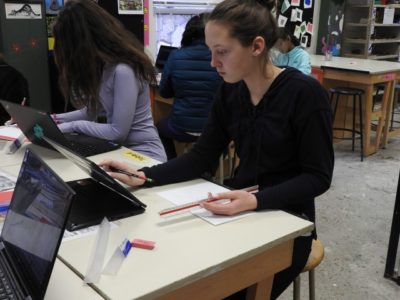
To address these challenges and create a positive learning environment in the studio, my students needed to be able to access my instruction at their own pace—not just a textbook where you can flip through the pages, but they needed to have the information available in a similar way in which it was presented. If only I could clone myself! Well, actually, that is exactly what I did. This is when my video journey began; since then my classroom and teaching approach have been transformed.
In the beginning, many hours were spent searching YouTube for the perfect video—one that had all the content I wanted to teach, was the appropriate length, clear speaking, etc. It was challenging to find exactly what I wanted and It didn’t take long to discover that creating my own videos was the way to go. My first one took about 10 hours to create. It was a paint mixing video and after doing all of the demonstrations (some over and over again) I began to edit. The final video worked well, however, 10 hours of work for six minutes of instruction did not seem like a good return on my investment.
Seven years later, the evolution of my videos included lots of learning about how to use programs like Adobe Premiere Pro and working with lighting, sound, and editing which allowed me to experiment with all of the options when creating a video. I now use a variety of these features: music, words on the screen, increasing/decreasing speed, and superimposed visuals and resources. I have since grown in my skill development and my videos have evolved into invaluable teaching tools and resources for my students. My return for the investment is in better balance now; students are engaged, independent learners, and behavior challenges in the studio have disappeared. I can edit a video in about 30 minutes and my YouTube channel has become a resource for my students as well as other teachers and artists. As I write this I have 1,660 subscribers, over 326,000 views, and I have published over 150 instructional videos.
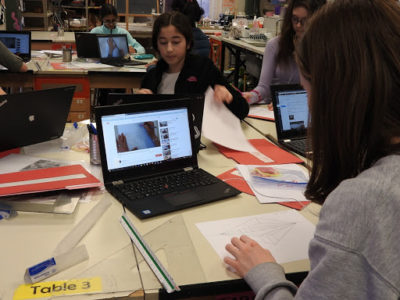
To address these challenges and create a positive learning environment in the studio, my students needed to be able to access my instruction at their own pace—not just a textbook where you can flip through the pages, but they needed to have the information available in a similar way in which it was presented. If only I could clone myself! Well, actually, that is exactly what I did. This is when my video journey began; since then my classroom and teaching approach have been transformed.
In the beginning, many hours were spent searching YouTube for the perfect video—one that had all the content I wanted to teach, was the appropriate length, clear speaking, etc. It was challenging to find exactly what I wanted and It didn’t take long to discover that creating my own videos was the way to go. My first one took about 10 hours to create. It was a paint mixing video and after doing all of the demonstrations (some over and over again) I began to edit. The final video worked well, however, 10 hours of work for six minutes of instruction did not seem like a good return on my investment.
Seven years later, the evolution of my videos included lots of learning about how to use programs like Adobe Premiere Pro and working with lighting, sound, and editing which allowed me to experiment with all of the options when creating a video. I now use a variety of these features: music, words on the screen, increasing/decreasing speed, and superimposed visuals and resources. I have since grown in my skill development and my videos have evolved into invaluable teaching tools and resources for my students. My return for the investment is in better balance now; students are engaged, independent learners, and behavior challenges in the studio have disappeared. I can edit a video in about 30 minutes and my YouTube channel has become a resource for my students as well as other teachers and artists. As I write this I have 1,660 subscribers, over 326,000 views, and I have published over 150 instructional videos.
What have I gained by infusing technology into my classroom?
- Students have access to exactly what I want them to learn at any time. Need clarification about a concept, tool, or technique? No problem—watch the video.
- A class structure that allows for students to move at their own pace. Ready to move on to the next step? No problem—watch the video.
- Students are held responsible for the information. Don’t remember the instructions or information presented? Absent from class that day? No problem—watch the video.
- Students learn how to independently navigate the studio. Want to work on an independent project using the wood bench? No problem—watch the videos!
This is not to say that I don’t do live teaching in the studio—the structure of the class allows for personal, in-person teaching which is then supported with the videos. The personal connection with my students is strengthened with this tool because it leaves space for me to work one-on-one with students without the rest of the class waiting to move forward. When a student walks into my classroom, they are confident that their learning needs will be met and that they can relax with the knowledge that they have access to resources that allow them to learn at their own time, place, path and pace.
So imagine this for a different ending to my meeting: In conclusion, the presenter announces, “I have a video recording of this meeting and will share the slides of my presentation.” A wave of relief spreads over me; I have access to the information presented and I can find the answers to my questions.
